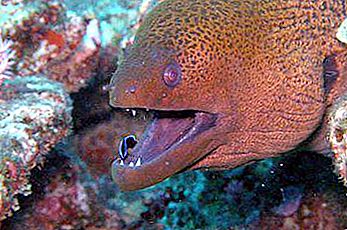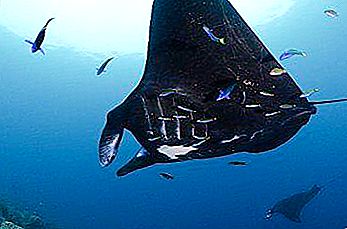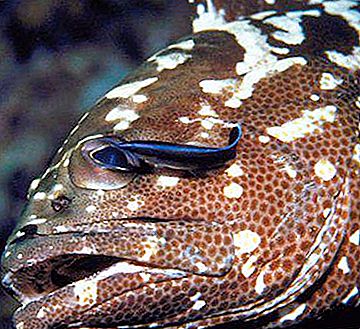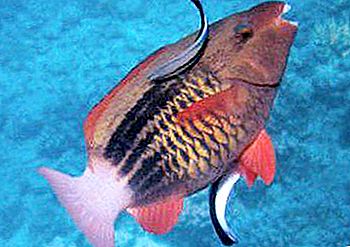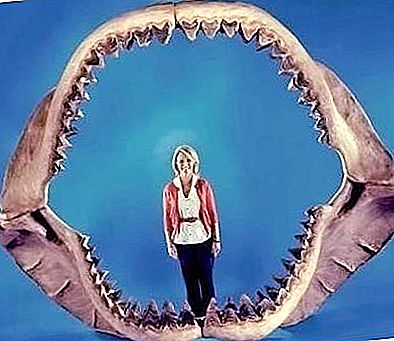The coral reefs of the Red Sea, the Indian and Pacific Oceans are a surprisingly diverse world, but our understanding of the processes that affect it is still quite limited.
For example, it was precisely possible to establish that cleaning fish have a huge impact on many aspects of life in this habitat. In addition, they are a prime example of mutually beneficial symbiosis. And what is it and what kind of “professions” does the fish-cleaner own, you will learn further.
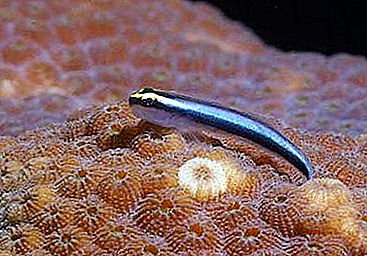
What does the cleaner do?
Over time, the body of any fish becomes home to many parasites that feed on the blood, mucus, or waste products of their host. Land animals are known to suffer the same problems, but they have paws, teeth, noses and claws with which they can help themselves or fellow brothers. But the fish do not have such capabilities, and here the “marine doctor” comes to the rescue - a small fish-cleaner.
It has a small size (no more than 14 cm). And this is justified, since during the processing it has to climb into the mouth and even into the gill slits of the “patients” exhausted by the parasites. The latter, by the way, go to search for “doctors” themselves and find blue-yellow fish in open coral reefs, where the cleaners arrange something like an “ambulance” station.
How does the “cabinet” of cleaning work
What the fish cleaner does, you can understand by observing how its “cabinet” works. In reefs, you can often find lines from different species of marine life, patiently waiting for the opportunity to get such help they need. Sometimes, of course, as in human clinics, there may be quarrels over the right to be the first to be cleaned, but, basically, the fish decorously wait in the wings.
Interestingly, even a kind of truce is declared at this time. That is, predatory moray eels can safely be close to their potential victims, without showing the slightest interest in them.
What kind of fish are cleaners
The most common fish cleaner is a representative of the Wrasse family (the so-called guban). The "profession" is due to the shape of their mouths, similar to tubes and armed with teeth of a special design, resembling tweezers, which allows them to examine each centimeter of the patient’s body as efficiently as possible.
Two species of fish from this family: Thalassoma lunare and Thalassoma amblycephalum - are incredibly sociable in nature, often working as a large flock similar to a swarm of bees. They surround, for example, a huge slope hovering lazily above them and enjoy this meeting no less than he does. Indeed, mutually beneficial cooperation is evident here: the ramp turns into a huge dining table for fish, receiving, in turn, a clean body and, accordingly, health.
Medical "professions" of fish cleaner
Cleaners are absolutely insatiable. It was verified that they can "take" about 300 fish per day, carefully collecting their unwanted tenants. At the same time, they do not forget about the remnants of food between the teeth of huge brothers. In addition, they eat algae growing on large bodies of warm-water fish, clean wounds, collecting dead skin, bacteria and fungi.
The fish that arrived “at the reception” calmly open their mouths, relax the gill slits and patiently, and sometimes even with obvious pleasure, wait for the end of the process.
Cleaners, usually acting in pairs, begin processing from the eyes, gradually moving to the gills, and then dive into the “patient ”’s mouth. If a fish has a wound, it will swim especially often so that the cleaners treat it. In warm waters, this is especially true, as parasites develop there with great speed. That is, as you probably already understand, both the “surgeon” and the “dentist” are all “professions” of fish cleaner.
How fish behave using the services of cleaners
When the “patient” feels that he no longer needs help, he can give the cleaner a signal, closing his mouth for a while. But do not be afraid, he will not eat his “doctor”, just in this way he reports that he is in a hurry.
But sometimes the fish-cleaner cannot resist the temptation to eat a piece of nutritious mucus covering the patient’s body (it must be said that this is her favorite treat), and then the indignant “client” shakes off the incompetent “doctor” and swims away. But, mind you, this is not trying to swallow it for the edification of the rest of the "medical" fraternity.
Why a pair of cleaners is better than one fish
Researchers from Stockholm University, finding out what "professions" the cleaner fish own, found interesting facts. It turns out that they bite off mucus more often than fish working alone. If a couple works, and the male and female are the best, then no such excesses are observed. Why?
As it turned out, the cleaners are following each other. And if the male (he is usually larger in size) discovers that the female has violated the rule, he pursues her to punish. Like this! But the females, due to this, work much better, and the "customers" are more likely to go to such mixed pairs of underwater "doctors".

